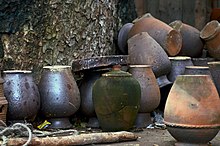
Philippine ceramics refers to ceramic art and pottery designed or produced as a form of Philippine art.
Contents


Philippine ceramics refers to ceramic art and pottery designed or produced as a form of Philippine art.

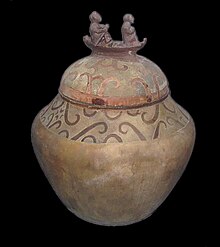

Traditional pot-making in certain areas of the Philippines would use clay found near the Sibalom River. Molding the clay required the use of wooden paddles, and the clay had to be kept away from sunlight. [1]
Native Filipinos created pottery since 3500 years ago. [1] They used these ceramic jars to hold the deceased. [2]
Other pottery used to hold remains of the deceased were decorated with anthropomorphic designs. These anthropomorphic earthenware pots date back to 5 BC. - 225 A.D and had pot covers shaped like human heads. [2]
Filipino pottery had other uses as well. During the Neolithic period of the Philippines, pottery was made for water vessels, plates, cups, and for many other uses. [3]
Kalinga Pottery [4]
Ceramic vessels of Kalinga are divided into three types: rice cooking (ittoyom), vegetable/meat cooking (oppaya), and water storage (immosso) pots. According to Skibo, the rice cooking pots are usually larger, thinner and have a smaller opening than vegetable/meat pots. On the other hand, water storage pots have an average and uniform size and a smaller neck size.
Except for water storage pots, which have a uniform size, the other two kinds can come in three different sizes, large, medium and small. Although this is true in some cases, another larger type of vegetable/meat pot and smaller water storage pot exists.
• Manufacture of Kalinga potteries

The first step in the manufacture of pots is the acquisition of the starting material, clay. The clay is then pounded, added with enough amount of water, to reach the wanted flexibility, and placed in a rotating plate. Using the hand-modeling and coil-and-scrape techniques, the height, thickness and shape of the pot is established. After this, the rim is designed by placing a wet rag on top of it and then rotating it in the other direction. Furthermore, scraping of the walls can also be done if the walls produced are too thick.
The pot, after the modeling stage, is then dried for a short period of time before the base is shaped. Also, after additional heating, small amounts of clay are added inside and outside the clay to maintain the evenness of the surface. A polishing step can also be done through the use of a polishing stone. In some cases, pots are also painted with red hematite paint for some stylized design.
Pottery Functions [4]
Pots are ceramic vessels that are made by molding clay into its wanted shape and then leaving it in an environment with an elevated temperature thereby making it solid and sturdy. It is widely recognized as one of better tools that humans invented since it managed to store the surplus of food Neolithic humans gathered.
In the book Pottery Function: A Use-Alteration Perspective, the author, James Skibo, reasoned out why the use of pots is far more advantageous than baskets and other organic containers. He said that since potteries are commonly made in clay, heat has little to none effect on the container, and its contents, and that it protects the food from moisture and pests. Furthermore, its range of storable contents is far wider than baskets and animal skins since it can store both liquid and dry goods.
Also, Rice, in his book Pottery Analysis, classified ceramic vessels into 17 categories depending on various factors that concern the use and production of the tool. One of these is the content wherein he further divided a type of pot into four depending on the state (liquid or solid) and temperature (hot or cold) of the food inside it. He also said that a ceramic has three main uses. These three are storage, processing, and transfer.
Based from these three uses that Rice gave, Skibo further characterized the usage of ceramic vessels by dividing the tool's function into two, (1) intended use and (2) actual use.
Intended use, as the name implies, is how the tool's supposed to be used. This is the basis of the manufacture of the ceramic vessel since the form follows the function. On the other hand, actual use is how the tool was used. This sometimes disregards the pot's form as long it can do a specific function.
Kalinga Pottery and its Uses [4]
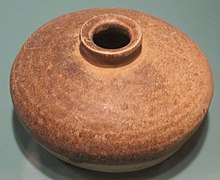
In Kalinga, ceramic vessels can be used for two situations: daily life use and ceremonial use. Daily life uses include the making of rice from the pots and the transfer of water from nearby water bodies to their homes.
• Determining actual function of Kalinga pots
As said, a pottery sometimes has a different actual use than intended use. This is the reason why when archaeologists study the function of a pottery, they tend to focus on how the tool was actually used. They do this by studying the alterations that the pottery has. These alterations, accretion and attrition, are commonly the abrasions and scratches on the vessel. In Skibo's study of Kalinga potteries functions, he relied on three main tests, namely (1) dissolved residue, (2) surface attrition and (3) carbon deposition.
Iron Age pottery [5]
There are three major complexes in Philippine Iron Age according to Solheim, Kalanay, Novaliches and Bau pottery complexes. Kalanay pottery complex pertains to Beyer's Early Iron Age pottery of the Visayan Islands found in Negros and Mindoro; novaliches pottery complex to Beyer's Early Iron Age pottery from Rizal province. Bau pottery, on the other hand, does not fit into the two previous complexes and could correspond instead to the Late Iron Age pottery.
Kalanay Pottery Complex [5]
The type site of the Kalanay pottery complex is the Kalanay Cave found in Masbate. From this site, the pottery is further subdivided into pottery types Kalanay and Bagupantao.
Specific varieties of decoration are as follows:
Kalanay complex pottery can be divided into 16 groups according to Solheim.
Bau Pottery Complex [5]
It has less variation in both form and decoration compared to the Kalanay pottery complex.
Specific varieties of decoration are as follows:
In terms of forms:
Novaliches Pottery Complex [5]

Most of Novaliches pottery can be distinguished from Bau pottery and Kalanay pottery. While it shares form and decoration with Kalanay pottery, it contains more variability compared to Bau pottery. According to Solheim (2002), “it is the most sophisticated pottery that has yet been found in the Philippines”
Novaliches pottery can be diagnosed by its form being a shallow bowl with a high right-foot. The shallow bowl is generally plain but the feet are highly decorated. Majority of Novaliches pottery were well polished. The form is so symmetrical that it looks as if it was made in a potter wheel, however, examinations showed that it wasn't.
Specific varieties of decoration are as follows:
Vessel forms are as follows:
Kalanay Cave Site [5]
The Kalanay cave site is a small burial cave. It is located at the northwest coast of Masbate.
• Kalanay Pottery
• Kalanay Incised
• Kalanay slipped
Bagupantao Pottery [5]
• Bagupantao Plain
• Bagupantao Impressed
• Bagupantao Painted
• Extraneous Pottery - Three vessels that did not belong to the Bagupantao and Kalanay style were also found.
First pot
Second pot
Third pot
In Japan, pottery from Luzon became especially esteemed and was used in Japanese tea ceremony as shimamono .

Pottery is the process and the products of forming vessels and other objects with clay and other raw materials, which are fired at high temperatures to give them a hard and durable form. The place where such wares are made by a potter is also called a pottery. The definition of pottery, used by the ASTM International, is "all fired ceramic wares that contain clay when formed, except technical, structural, and refractory products". End applications include tableware, decorative ware, sanitaryware, and in technology and industry such as electrical insulators and laboratory ware. In art history and archaeology, especially of ancient and prehistoric periods, pottery often means vessels only, and sculpted figurines of the same material are called terracottas.

Maya ceramics are ceramics produced in the Pre-Columbian Maya culture of Mesoamerica. The vessels used different colors, sizes, and had varied purposes. Vessels for the elite could be painted with very detailed scenes, while utilitarian vessels were undecorated or much simpler. Elite pottery, usually in the form of straight-sided beakers called "vases", used for drinking, was placed in burials, giving a number of survivals in good condition. Individual examples include the Princeton Vase and the Fenton Vase.

Pottery and porcelain is one of the oldest Japanese crafts and art forms, dating back to the Neolithic period. Kilns have produced earthenware, pottery, stoneware, glazed pottery, glazed stoneware, porcelain, and blue-and-white ware. Japan has an exceptionally long and successful history of ceramic production. Earthenwares were made as early as the Jōmon period, giving Japan one of the oldest ceramic traditions in the world. Japan is further distinguished by the unusual esteem that ceramics hold within its artistic tradition, owing to the enduring popularity of the tea ceremony.
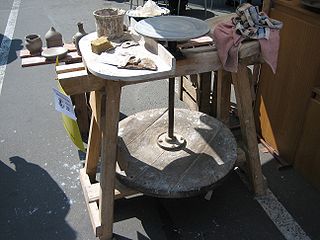
In pottery, a potter's wheel is a machine used in the shaping of clay into round ceramic ware. The wheel may also be used during the process of trimming excess clay from leather-hard dried ware that is stiff but malleable, and for applying incised decoration or rings of colour. Use of the potter's wheel became widespread throughout the Old World but was unknown in the Pre-Columbian New World, where pottery was handmade by methods that included coiling and beating.

Ceramics of Indigenous peoples of the Americas is an art form with at least a 7500-year history in the Americas. Pottery is fired ceramics with clay as a component. Ceramics are used for utilitarian cooking vessels, serving and storage vessels, pipes, funerary urns, censers, musical instruments, ceremonial items, masks, toys, sculptures, and a myriad of other art forms.
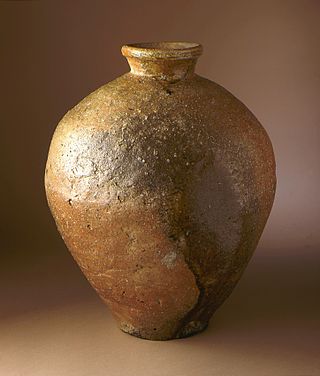
Shigaraki ware (信楽焼) is a type of stoneware pottery made in Shigaraki area, Japan. The kiln is one of the Six Ancient Kilns in Japan. Although figures representing the tanuki are a popular product included as Shigaraki ware, the kiln and local pottery tradition has a long history.

Vietnamese ceramics refers to ceramic art and pottery as a form of Vietnamese art and industry. Vietnamese pottery and ceramics has a long history spanning back to thousands of years ago, including long before Chinese domination, as archeological evidence supports.

Pottery and ceramics have been produced in the Levant since prehistoric times.

Black-burnished ware is a type of Romano-British ceramic. Burnishing is a pottery treatment in which the surface of the pot is polished, using a hard smooth surface. The classification includes two entirely different pottery types which share many stylistic characteristics. Black burnished ware 1 (BB1), is a black, coarse and gritty fabric. Vessels are hand made. Black burnished ware 2 (BB2) is a finer, grey-coloured, wheel thrown fabric.

Mississippian culture pottery is the ceramic tradition of the Mississippian culture found as artifacts in archaeological sites in the American Midwest and Southeast. It is often characterized by the adoption and use of riverine shell-tempering agents in the clay paste. Shell tempering is one of the hallmarks of Mississippian cultural practices. Analysis of local differences in materials, techniques, forms, and designs is a primary means for archaeologists to learn about the lifeways, religious practices, trade, and interaction among Mississippian peoples. The value of this pottery on the illegal antiquities market has led to extensive looting of sites.

The Summer Island site, designated 20DE4, is an archaeological site located on the northwest side of Summer Island, in Delta County, Michigan. It is classified as a stratified, multi-component site with Middle Woodland, Upper Mississippian and Early Historic/Protohistoric occupations. It was listed on the National Register of Historic Places in 1971.
Lohari Ragho is a village and Indus Valley civilization archaeological site, located in Hisar district of the Haryana state in India. It has 3 separate mounds, each 1 to 1.5 km apart within the peripheral suburban zone of Rakhigarhi city cite, where artifacts belonging to Mature Harappan and Sothi-Siswal cultural period have been confirmed based on filed visits. These mounds, unprotected and under risk of encroachment and threat of obliteration, are yet to be excavated, fenced, protected or conserved.

Pampanga lies within the Central Plain region and has a total land area of 2,180.70 square kilometers. Together with Bulacan, Nueva Ecija, Pangasinan and Tarlac, the region includes a total area of approximately 5,900 square miles, mostly composed of lowlands and arable areas.
The Kalinga Ethnoarchaeological Project (KEP), based in the Cordillera Mountains of the Philippines, was one of the longest-running ethnoarchaeological projects in the world. It was initiated by William Longacre, professor at the University of Arizona, in 1973. Lasting for almost 20 years, research focused on pottery production, use, exchange, and discard, and was carried out by Longacre and his team of Kalinga assistants, archaeology students, and colleagues.
Laguna is a province of the Philippines found in Southern Luzon and features a freshwater lake and river valleys surrounded by arable land. This makes Laguna a good site for potential archeological sites. Its lake basin and fertile land makes for the area easily habitable, granting early settlers an accessible source of fish, eels, game and grain to support a thriving community of people. The coasts rivers of Laguna give the region a quick method of transportation and make trade with foreign merchants easier.
The Kalanay Cave is a small cave located on the island of Masbate in central Philippines. The cave is located specifically at the northwest coast of the island within the municipality of Aroroy. The artifacts recovered from the site were similar to those found to the Sa Huynh culture of Southern Vietnam. The site is part of the "Sa Huynh-Kalanay Interaction Sphere" which was an Iron Age maritime trading network associated with the Austronesian peoples of the Philippines, Vietnam, Taiwan, as well as most of northeastern Borneo and Southern Thailand. The type of pottery found in the site were dated 400 BC to AD 1500. The "Sa Huynh-Kalanay Interaction Sphere" is characterized by a remarkable continuity in trade goods, including decorated pottery and double-headed pendants and earrings known as lingling-o.
Philippine ceramics are mostly earthenware, pottery that has not been fired to the point of vitrification. Other types of pottery like tradeware and stoneware have been fired at high enough temperatures to vitrify. Earthenware ceramics in the Philippines are mainly differentiated from tradeware and stoneware by the materials used during the process and the temperature at which they are fired. Additionally, earthenware and stoneware pottery can generally be referred to as ceramics that are made with local materials, while tradeware ceramics can generally be referred to as ceramics that are made with non-local materials.

Cord-marked pottery or Cordmarked pottery is an early form of a simple earthenware pottery. It allowed food to be stored and cooked over fire. Cord-marked pottery varied slightly around the world, depending upon the clay and raw materials that were available. It generally coincided with cultures moving to an agrarian and more settled lifestyle, like that of the Woodland period, as compared to a strictly hunter-gatherer lifestyle.
The Carcajou Point site is located in Jefferson County, Wisconsin, on Lake Koshkonong. It is a multi-component site with prehistoric Upper Mississippian Oneota and Historic components.
Hirbemerdon Tepe is an archaeological site in Turkey located in the east of Diyarbakir Province, on the western bank of the Tigris River, 40 kilometers east of Bismil, Turkey. The settlement began in the fourth millennium BCE during the Chalcolithic era, and continued to the time of the Ottoman Empire. The earliest pottery at the site is similar to the chaff-faced ware of Uruk period.
![]() Media related to Ceramics of the Philippines at Wikimedia Commons
Media related to Ceramics of the Philippines at Wikimedia Commons